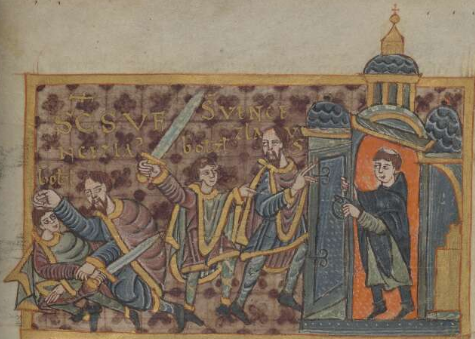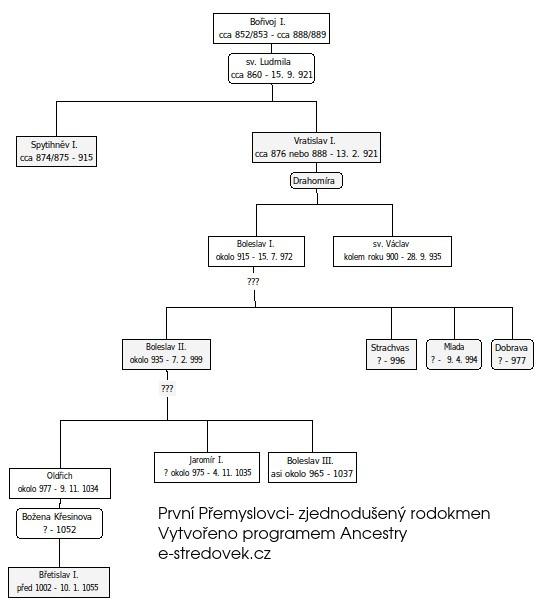Saint Wenceslaus
The birth of Prince Wenceslas is dated somewhere around 900 - its correct attribution is influenced by many factors - for example, the determination of the year of birth of his father Vratislav I, the credibility of the data from the legends and the accuracy of the data resulting from anthropological research of Wenceslas’ remains. Historians therefore dispute this date (as well as the year of his death). The time interval in which it most likely lies is between 895 and 907.
Apart from the legendists, other contemporary sources, such as the Saxon chronicler Widukind or the Arab geographer al-Masudi, also report the existence of Prince Wenceslas. According to the legends, Wenceslas was brought up in his childhood by his grandmother Ludmila and taught by Slavic and Latin priests.

Duke Vratislav and his son Wenceslaus as a pupil, Velislav’s Bible, ca. 1340, source: Manuscriptorium
After Vratislav’s death in 921 he was appointed his father’s successor on the Bohemian princely throne. According to the legends, however, he was still too young (18 years old) to take the reign independently. His mother Drahomíra therefore ruled as regent for him. However, she came into conflict with her mother-in-law Ludmila and had her murdered by her assistants Tunna and Gommon at the castle of Tetin. She then took over the government with them. However, there was a coup d’état, of which it is written in the Christian legend: “For this matter there arose afterwards a great quarrel between the nobles who sided with the pious duke and the others who sided with the wicked mistress. And the counsellors and chief men of the land were divided, and the thorns of strife between them were stirred up to bloodshed. And the side of the righteous, though small, overcame the mighty side of the wicked, as is always the case.” So Wenceslaus’ less numerous party triumphed, and the young prince sent Drahomira into exile as a punishment. He himself took over the government of Bohemia.
Exactly when this political upheaval took place is again a matter of debate. It may have happened shortly after Ludmilla’s death, because it is known from German chronicles that in early 922 Duke Arnulf of Bavaria came to Bohemia with his army and restored the dependence of the Bohemian principality on Bavaria (which had already begun in 895). It is possible that this campaign was related to the accession of Prince Wenceslas - he could have been enthroned by Arnulf. At the same time, however, it would mean that Wenceslaus was pro-Bavarian in the early part of his reign. Dušan Třeštík, however, places the expulsion of Drahomíra as far back as 924/925.

Saint Wenceslaus, The Legend of Gumpold (Passio b. Pantaleonis martiris (Cod. Guelf. 11.2 Aug. 4°; Heinemann-Nr. 3008)), c. 1006, fol. 18v.
Wenceslaus then went on to unify the country - the legendist Christian says that Wenceslaus conquered the territory of the prince of Kouřim (according to Dalimil’s chronicle Radslav). He also completed the construction of St. George’s Basilica on the acropolis of Prague Castle. In 925 he had the remains of his grandmother Ludmilla of Tetín transferred here. Later he built another sacral building to the west of this church - a rotunda dedicated to St. Vitus.
In 929, the German King Henry the Fowler carried out a successful campaign against the Slavs of Polabje and then invaded Bohemia. At the same time, the Bavarian Arnulf came from the southwest to Prague. Wenceslas was forced to submit to Henry - thus changing the foreign policy orientation of Bohemia from Bavaria to Saxony.
According to later legends, Wenceslas was to receive the relics of St. Vitus from King Henry for his loyalty. It is probable that Wenceslas was already striving for the ecclesiastical independence of Bohemia, i.e. the establishment of the bishopric of Prague.
Wenceslaus continued the efforts of his grandfather, uncle and father to Christianise the - still largely pagan - country. By his actions, and especially by the abundant support of the incoming priests, he aroused the opposition of some of the high-ranking Bohemian nobles, especially those who were close to Václav’s younger brother Boleslav. A conspiracy was organised against Wenceslaus.
Wenceslaus was probably murdered by his companions Hněvsa, Tira, Tuža and Česta on 28 September 935, during a visit to his brother Boleslav at his castle in present-day Stará Boleslav. Boleslav “the brother-killer” then took over the government.

The Murder of St. Wenceslaus, The Legend of Gumpold (Passio b. Pantaleonis martiris (Cod. Guelf. 11.2 Aug. 4°; Heinemann-Nr. 3008)), c. 1006, fol. 21r.
According to legends, Wenceslaus was married and even had a son Zbraslav. However, nothing is known from contemporary sources about the fate of Wenceslaus’ wife and child.

The First Přemyslids, simplified family tree (in Czech)
Wenceslaus was first buried in Boleslav and later (according to legends after 3 years, according to D. Třeštík after 30 years) his remains were transferred to Prague and placed in the rotunda of St. Vitus. His brother Boleslav thus essentially decided on Wenceslaus’ canonization. Later, St. Wenceslas became the patron and “eternal duke” of the Czechs.
According to anthropological expertise, Wenceslas was tall and slender for his time, with an elongated face, fair-haired and probably blue-eyed. Judging by the muscle tendons on his bones, he must have been muscular and physically fit.